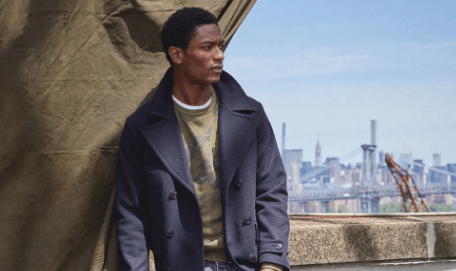The peacoat, a classic and enduring piece of outerwear, has a rich history that spans centuries. Its distinctive double-breasted design, wide lapels, and robust construction have made it a timeless choice for individuals seeking a combination of style, warmth, and versatility. This iconic coat carries a legacy of both practicality and fashion, evolving from its naval origins to becoming a staple in modern wardrobes.
Introduction: The pea coat’s origin can be traced back to the early 18th century when it was first worn by sailors in European navies. This naval heritage, combined with its elegant design, has propelled the pea coat from its utilitarian beginnings to becoming a coveted fashion item.
Naval Roots and Functionality: The pea coat’s design was initially intended to offer sailors protection against the harsh maritime conditions. Its double-breasted front, notched lapels, and durable woolen fabric provided insulation against the cold winds and moisture encountered at sea. The anchor-embossed buttons added a touch of maritime symbolism to these practical garments.
Design and Features: Characterized by its double-breasted construction, wide lapels, and a boxy silhouette, the pea coat exudes a sense of timelessness and sophistication. The coat is typically tailored to hit just below the hips, offering ample coverage while allowing freedom of movement. The unique collar design, which can be worn flipped up for added protection, contributes to the pea coat’s distinct appearance.
Materials and Warmth: Traditionally crafted from heavy wool, the pea coat is renowned for its ability to provide exceptional warmth and insulation. The thick woolen fabric ensures that wearers remain comfortable in chilly weather, making it an ideal choice for autumn and winter months.
Versatility in Styling: One of the remarkable qualities of the pea coat is its versatility in styling. It seamlessly complements a wide range of outfits, from casual jeans and sweaters to more formal ensembles. Its classic design ensures that it remains a versatile option across various settings.
Variety of Colors: While the classic navy blue remains a popular choice for pea coats, modern variations offer a spectrum of colors, ranging from traditional hues to more contemporary shades. This diversity allows individuals to select a pea coat that best aligns with their personal style.
Cultural and Historical Significance: The pea coat’s rich history extends beyond its naval roots. It became a staple of European and American fashion in the mid-20th century, embodying both a sense of nostalgia and a symbol of timeless elegance. Its association with military aesthetics adds an air of authority to its allure.
Modern Adaptations: As fashion evolves, the pea coat has also undergone modern adaptations. Designers have experimented with different materials, lengths, and cuts while retaining the classic double-breasted structure. These adaptations cater to contemporary tastes while preserving the essence of the traditional pea coat.
Care and Maintenance: Maintaining a pea coat’s quality involves proper care and maintenance. Woolen materials require occasional cleaning and gentle handling to preserve their texture and appearance. Adequate storage and adherence to care instructions are essential for ensuring the coat’s longevity.
Conclusion: The pea coat’s journey from naval attire to an iconic fashion piece is a testament to its enduring appeal and versatile design. As it seamlessly combines historical significance with modern style, the mens peacoat remains a cherished addition to wardrobes worldwide. Whether worn by sailors navigating treacherous seas or individuals navigating bustling streets, the pea coat stands as a symbol of timeless elegance and unwavering functionality.



